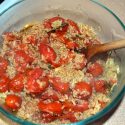Healthy eating for diabetes
Diabetes is a disease that strikes fear in the hearts of many. And with good reason! Diabetes is the seventh leading cause of death and disability in the United States. It can also contribute to the first (heart disease), fifth (stroke), and ninth (kidney disease) leading causes of death and disability.
But there’s good news! Diabetes can be very effectively managed with diet, exercise, sometimes medication or insulin injections, regular check-ups, and consistent self-monitoring. With these interventions, many of the co-morbidities (like blindness, amputations, heart disease, and kidney disease) can be stalled or avoided completely. In fact, for some people, diabetes can even be reversed!
Managing diabetes is multi-faceted, and typically involves several different specialists in addition to the hard work of the person with diabetes. In this article, I’m going to focus on food and why a healthy diet is so important for people with diabetes. This should not be taken as individual advice, and you should always consult your doctor or a dietitian (medical nutrition therapist) for individual guidance. If you’re not sure where to turn, contact a Health Care Concierge to discuss your plan coverage: 1-888-876-2756
Carbohydrates are the body’s main — and most efficient — source of energy. Carbohydrates get digested into glucose, which is the only sugar our cells can use for fuel. Once digested, the glucose enters our bloodstream and triggers the pancreas to release insulin. Insulin is like a key that lets glucose into our cells for use (read more here). When someone has diabetes, there is a problem with glucose getting into cells. Either there is not enough insulin (type 1, and sometimes type 2 diabetes), or the cells are resistant to the action of insulin and the glucose can’t get into the cells (type 2 diabetes), and glucose levels in the blood rise.
It’s important to have well-balanced meals to maintain blood sugar, and carbohydrate intake is a vital part of that. Since carbohydrates have the greatest impact on your blood sugar levels, you may be asked to keep a close eye on the amount you eat every day. Regardless, strive to be consistent with carbohydrate intake at each meal. That way, you can minimize blood sugar spikes as much as possible. A diabetic diet is not a low-carbohydrate diet. Unless your doctor or dietitian recommends something different, carbohydrate intake should be somewhere between 45 to 65 percent of your calorie intake (that’s about 225 to 325 grams per day for a 2,000-calorie diet). Carbohydrates include sugars, starch, and fiber.
Healthy carbohydrate choices include:
- Whole fruit
- Vegetables
- Whole grains
- Legumes
- Low-fat or fat-free milk
These are better choices for carbohydrate intake because they contain other elements besides just carbohydrates. These foods contain a multitude of vitamins and minerals, as well as fiber and/or protein, which can help control the impact of the carbohydrate on blood sugar. Choose low-fat or fat-free to help minimize your risk for heart disease.
A note on fiber
Most people are fiber-deficient. Fiber is important for moderating blood sugars, in addition to maintaining proper bowel function, maintaining healthy cholesterol levels, functioning as a pre-biotic (food for your “good” bacteria), and helping you feel fuller longer. It is recommended to eat at least 25 to 35 grams of fiber per day, but it’s not a problem to eat more than that for most people. Fiber is found in plant foods like fruits, vegetables, and whole grains. It is better to get your fiber through food rather than a supplement.
Historically, people with diabetes were told to avoid sugar, but research over the past 10 years has shown the total amount of carbohydrates matters more than the source when it comes to blood sugar control (sugar is a type of carbohydrate). Of course, most carbohydrate choices should be high quality, but these studies have suggested it’s all right to include an occasional sugary treat as long as another carbohydrate choice is removed (e.g., you choose to have half a cup of pudding for dessert, instead of a slice of bread with dinner).
Sugar substitutes do not contain carbohydrates, and can be good choices to help avoid unnecessary carbohydrate intake. But beware! Many commercially produced sugar-free items, like cookies, pies, and other desserts, contain just as many carbohydrates as the regular version — sometimes more! Be sure to look at the nutrition label to make sure you know what you’re eating.
Here are some ways to improve the quality of your carbohydrate intake:
- Switch to 100 percent whole-wheat bread.
- Use brown rice or quinoa instead of white rice.
- Use 100 percent whole wheat, or brown rice/quinoa pasta instead of white pasta.
- Use whole-wheat pastry flour in baking instead of white flour.
- Experiment with ancient grains like amaranth, millet, and sorghum.
- Purchase whole-grain buckwheat or 100 percent whole-wheat pancake mix (or make your own!).
- Eat whole fruit instead of drinking fruit juice (even 100 percent fruit juice should be limited).
- Use pureed chickpeas or other legumes in creamy soup instead of cream or whole milk.
- Look for sugar-free, low-fat, or fat-free yogurt.
- When you want soda, opt for diet.
- Drink water most of the time (sugar-free flavored water is acceptable, too).
- Choose fat-free milk for your coffee instead of flavored creamers.
- Make your own granola or opt for oatmeal, cream of wheat, or grits for breakfast instead of sugary cereals (even “healthy” cereals are often high in sugar). Avoid packets with added sugar, and add frozen or fresh fruit instead of sugar or honey.
- Use starchy vegetables like potatoes, peas, corn, and winter squash in place of a grain for some meals to keep carbohydrate intake consistent.
- Leave the skins on potatoes for a fiber boost (even sweet potato skins are edible!).
- Fill up on nonstarchy vegetables like spinach, zucchini, tomatoes, peppers, broccoli, carrots, asparagus, Brussels sprouts, onions, snap peas, beets, cauliflower, etc.
Most people know protein is essential for healthy muscles. But proteins have hundreds of other functions, too, including maintaining cell structure, function, and regulation of the body’s tissues and organs. Many of our immune cells are proteins. So are enzymes, some hormones, transport molecules, and parts of DNA.
Protein does not contribute much to blood sugar levels, and can help you feel fuller longer. Protein can also help moderate blood sugar spikes if eaten with a carbohydrate. As with carbohydrates, quality matters with protein choice. Since people with diabetes are at an increased risk for heart disease and kidney disease, it’s important to choose high-quality protein sources that are low in fat and cholesterol, without overdoing it. Just 6-9 ounces of protein per day is adequate for most people (about 15 to 25 percent of total calories, 75 to 125 grams per day for a 2,000-calorie diet). It’s worth noting that most foods have at least a little protein in them, and that all adds up over the day!
The best protein sources include:
- Legumes
- Nuts and seeds (in moderation)
- Chicken without the skin, low-fat preparation
- Fish, low-fat preparation
- Egg whites (yolks are high in cholesterol; consume no more than three to seven per week – your doctor or dietitian may recommend fewer)
Here are some tips for including the right amount of healthy protein in your diet:
- Try a meatless meal once a week and include some legumes, like black beans or chickpeas.
- Make scrambled egg whites with sautéed onions, garlic and spinach folded in (top with salsa if you’d like) for breakfast instead of whole scrambled eggs.
- Purchase skinless chicken, or remove the skin and cut off all fat you see before cooking.
- Dip chicken tenderloins in fat-free milk, cover with chopped pecans and bake instead of deep frying or using bread crumbs.
- Use cooking methods like baking, broiling, grilling, or roasting.
- Once in a while, it’s all right to use fattier meats like beef and some cuts of pork as a garnish instead of the main event — casseroles are great for this!
- Weigh out your protein portion after cooking. A proper serving size is about three ounces (the size of a deck of cards).
- Include fish two or three times a week.
Fat got a bad rap in the ’80s, but is actually a vital part of health. While it’s true that too much fat can be unhealthy, and might cause weight gain, the same is true of both protein and carbohydrates! Fat’s vital functions in the body include providing and storing energy (for use when carbohydrates are not available), allowing for absorption of fat-soluble vitamins A, D, E, and K, maintaining core body temperature, and insulating your body and organs. Some fats even play a role in maintaining healthy cholesterol levels!
Besides all that, fat tastes good! It can help you feel fuller longer, and provides an extra layer of satisfaction with our food. In addition, like protein, fat contributes little to blood sugar levels. But fat is high in calories — nine calories for every gram (versus four calories in every gram of protein and carbohydrate), so it’s easy to overdo! The best way to include fats is to replace unhealthy fats with small amounts of healthy fats, rather than just adding more fat to your diet. Around 30 percent of your total calorie intake should come from fat (that’s about 60 grams a day for someone following a 2,000-calorie diet).
Unhealthy fats are known to contribute to heart disease in the amounts Americans typically consume them. There are two types of these fats; trans fats and saturated fats. Trans fats are usually found in commercial baked goods, cookies, crackers, fast food, stick margarine, and shortening. It is recommended to avoid consuming any trans fat (more on trans fat here). Saturated fat, on the other hand, is required by your body in very small amounts. It is recommended to consume less than 10 percent of your calories from saturated fat. That’s less than 22 grams per day for someone following a 2,000-calorie diet. Saturated fat is usually solid at room temperature, and includes foods like butter, visible animal fat, lard, bacon grease, milk fat, cheese, and tropical oils like coconut and palm kernel oils. These types of fats can contribute to heart disease, since your body uses them to make cholesterol (which can clog your arteries if it gets too high).
Cholesterol isn’t really a fat, but it is typically found in foods that are high in saturated fat, so we talk about them together. Much of your blood cholesterol levels are dependent on your trans and saturated fat intake; however, the amount of cholesterol you eat does contribute, especially since people with diabetes are already at risk for heart disease. The American Heart Association recommends consuming less than 300mg of cholesterol per day (your doctor/dietitian may recommend even less if you have high cholesterol). Cholesterol is found in any animal product. The highest amounts are in organ meat (like liver), egg yolks, and shrimp — but also in milk fat, butter, lard, bacon grease, cheese, and beef.
Healthy fats, on the other hand, can help decrease cholesterol that is high, and maintain healthy cholesterol levels over time. These fats are called monounsaturated and polyunsaturated fats. Those are long names, so it’s sometimes easier just to remember the foods that are good sources of them! These include:
- Vegetable oils like olive, canola, peanut, and soybean oils
- Olives
- Nuts and seeds
- Peanut butter (watch the ingredients for hydrogenated oils!)
- Tub and spray margarine
- Fatty, cold-water fish like salmon, mackerel, and tuna
- Avocados
Here are some tips to reduce unhealthy fat and cholesterol intake and include healthy fats:
- Replace the cheese on your salad with a handful of walnuts or sunflower seeds.
- Use a half tablespoon of peanut butter on your toast instead of butter.
- Replace half (or more) of the fat in baking with unsweetened applesauce.
- Include baked or broiled fish for dinner two or three nights a week.
- Make gravy using chicken broth or stock and thicken with corn starch or a little whole-wheat pastry flour instead of using meat drippings.
- Smear ripe avocado on your sandwich instead of mayonnaise.
- Remove all visible fat from chicken, pork and beef before
- Eat processed meats like luncheon meat, sausage, and bacon rarely (one serving a week or less).
- Use a small amount of Italian, balsamic vinaigrette, or oil and vinegar on your salad instead of ranch, bleu cheese or Thousand Island dressing.
- Make your own marinades using spices and acids like lemon, vinegar, or fat-free plain yogurt instead of oils.
- Use two egg whites, a mashed banana, applesauce, or a “flax egg” (one tablespoon of ground flax mixed with three tablespoons of water) for each egg in baking.
Sodium
People living with diabetes should consume less than 1,500mg of sodium per day. Too much sodium can increase blood pressure, further increasing your risk for a cardiac event. Look at nutrition labels to make sure you’re not overdoing it with sodium. Most of our sodium intake doesn’t come from the salt shaker at all! Foods that are high in sodium are usually highly processed foods like chips, crackers, pretzels, cheese, frozen meals, deli meat, canned soups and vegetables, vegetable juice, restaurant food, and condiments. Also check the bread you use to make sure the sodium is at an acceptable level. In general, the more foods you are able to prepare yourself, the more control you have over how much sodium is in the food.
Beverages
Many beverages today contain far more sugar in one container than anyone should consume in a whole day. It helps to look at both the nutrition facts panel and the ingredient list to determine if there’s too much sugar. In general, it’s best to avoid consuming sugar in beverages. It enters the blood stream quickly and causes spikes in blood sugar while providing little benefit. Beverages like regular soda, fruit juice (even 100 percent), sports drinks, coffee beverages (lattes and mochas), and energy drinks should not be consumed often. It’s important to stay properly hydrated, however, so the body can function optimally. Here are some beverages to stick to most often:
- Water (add lemon or other fruit for flavor)
- Carbonated water with a lime or lemon twist
- Black coffee or tea (sugar substitutes, and fat-free or 1% milk is fine to add)
- Sugar-free flavored waters
- Diet soda
A note on alcohol:
Alcohol can be a slippery slope with diabetes. Alcoholic drinks typically contain a lot of carbohydrates — both in the alcohol and as added sugar in mixed drinks. However, it’s not uncommon for blood sugars to dip too low after consuming alcohol. Make sure to ask your doctor or dietitian about how to safely consume alcohol if this applies to you!
Making sure you’re eating healthy can take a lot of planning and learning up front. But once you’ve been at it for a while, it will be just like your current habits — you’ll do it without even thinking about it. I applaud you for making your health a priority, and for your commitment to a better tomorrow!
If you want help with a lifestyle change, be sure to give our health coaches a call: 1-800-807-0751








